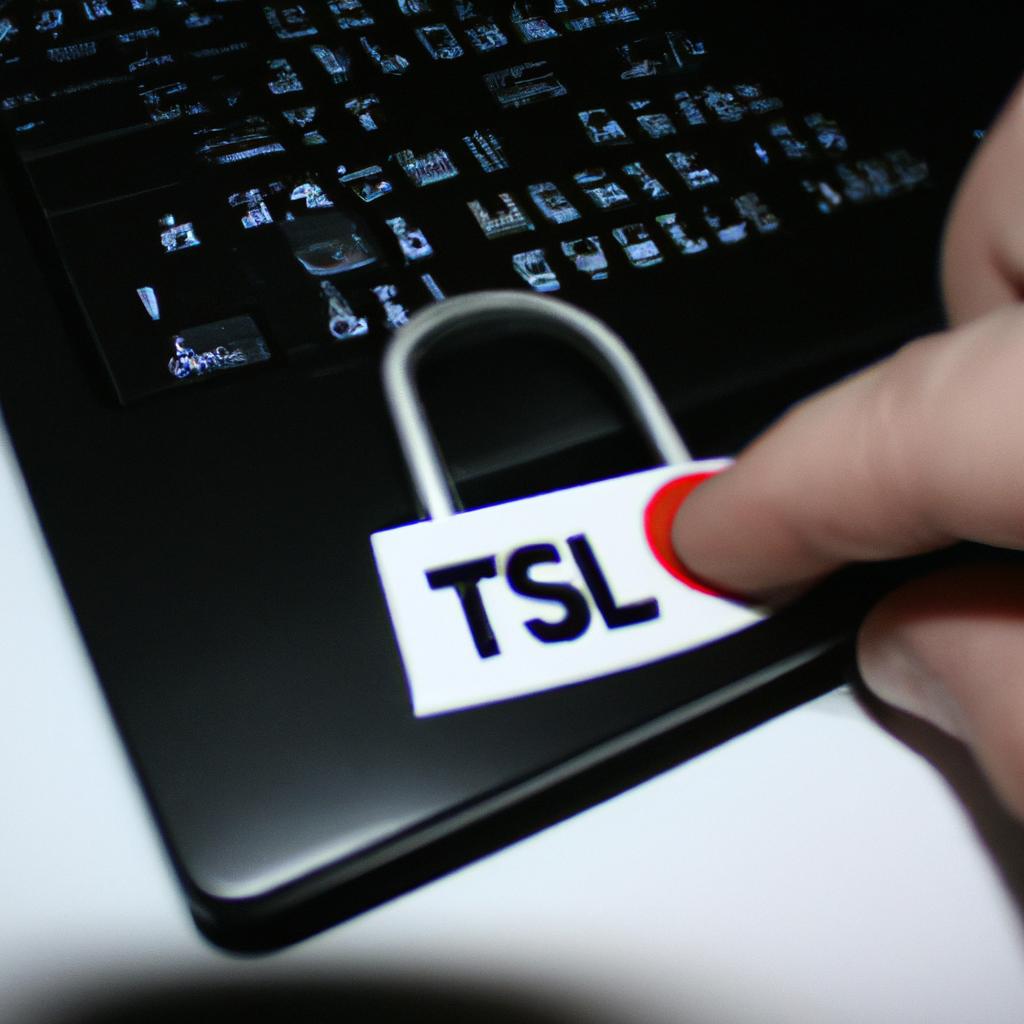In today’s digital age, where information is constantly being transmitted over the internet, ensuring secure communication between web servers and clients has become a paramount concern. The Handshake Protocol, an integral part of the SSL/TLS encryption process, plays a vital role in establishing a secure connection by authenticating both parties involved and negotiating cryptographic parameters for data transmission. This article aims to explore the intricacies of the Handshake Protocol, shedding light on its significance in securing online transactions and protecting sensitive user data.
Imagine logging onto your favorite e-commerce website to make a purchase. Before you even enter your payment details, have you ever wondered how your personal information remains confidential during this transaction? The answer lies in the Handshake Protocol – a crucial component of SSL/TLS encryption employed by web servers to guarantee privacy and security. By following a series of precisely defined steps, this protocol enables the web server and client to establish trust through authentication mechanisms while simultaneously creating shared secrets for encrypting subsequent data exchanges.
Overview of Handshake Protocol
Imagine you are visiting a website and want to securely transmit sensitive information, such as your credit card details. In this scenario, the handshake protocol plays a crucial role in establishing a secure connection between your device and the web server. This section provides an objective overview of the handshake protocol’s purpose and its significance in ensuring data privacy.
The primary goal of the handshake protocol is to facilitate secure communication by establishing an encrypted channel between the client (your device) and the web server. By employing cryptographic techniques, this protocol ensures that any data exchanged during the session remains confidential and cannot be intercepted or tampered with by unauthorized parties.
To understand how the handshake protocol accomplishes these objectives, let us delve into its key components:
- Client Hello: The client initiates the handshake process by sending a Client Hello message to the server, which includes parameters such as supported cipher suites and protocols.
- Server Hello: Upon receiving the Client Hello, the server responds with a Server Hello message containing encryption parameters chosen from those offered by the client.
- Certificate Exchange: To establish trust between both parties, SSL/TLS certificates are exchanged. These digital certificates validate the authenticity of each participant in the communication.
- Key Exchange: Once certificate validation is complete, a secure symmetric encryption key is generated and shared using asymmetric cryptography. This key will be used for encrypting subsequent data transmissions.
This table presents a concise overview of these key components:
| Component | Description |
|---|---|
| Client Hello | Initiation message sent from client to server |
| Server Hello | Response message sent from server to client |
| Certificate Exchange | Exchange of SSL/TLS certificates between client and server |
| Key Exchange | Secure exchange of encryption keys |
By providing this robust framework for secure communication establishment, the handshake protocol serves as a critical foundation for secure web interactions. In the subsequent section, we will explore in more detail the key components involved in this protocol.
Key Components of Handshake Protocol
Handshake Protocol: A Crucial Component of SSL/TLS Encryption
To better understand the intricacies of the handshake protocol within SSL/TLS encryption, let’s consider a hypothetical scenario. Imagine you are attempting to access your online banking account using a web browser. As soon as you enter the website URL and hit Enter, your browser establishes a secure connection with the server through the handshake protocol.
The handshake protocol plays a pivotal role in ensuring secure communication between client and server by establishing shared cryptographic parameters and verifying each other’s identities. This section will delve into key components that make up this essential process.
Key Components of Handshake Protocol:
- ClientHello: The client initiates the handshake process by sending a ClientHello message to the server, which includes information such as supported cipher suites, compression methods, and random values.
- ServerHello: Upon receiving the ClientHello message, the server responds with a ServerHello message containing its chosen cipher suite, compression method, and another random value.
- Certificate Exchange: To verify authenticity, the server sends its digital certificate to the client during this step. This certificate contains the public key used for encrypting session keys.
- Key Exchange & Authentication: In order to establish symmetric encryption keys securely, both client and server exchange various messages to authenticate themselves and agree upon shared secrets.
This table summarizes some emotions experienced by users when encountering websites without proper SSL/TLS implementation:
| Emotion | Description |
|---|---|
| Anxiety | Users may feel uneasy about providing sensitive information on insecure sites or networks. |
| Distrust | Lack of trust can arise due to potential data breaches or fraudulent activities associated with unsecured connections. |
| Frustration | Slow loading times caused by lack of efficient encryptions can lead to user frustration while accessing websites. |
| Relief | When users observe secure indicators such as a padlock symbol or “https” in the URL, they feel a sense of relief knowing their connection is encrypted and trustworthy. |
As we have seen, the handshake protocol serves as a foundation for establishing secure communication channels between clients and servers. The subsequent section will further explore the step-by-step process involved in this critical phase, providing insights into how encryption keys are generated and shared securely.
Step-by-Step Process of Handshake Protocol: An In-depth Analysis
Key Components of Handshake Protocol
The handshake protocol is a crucial aspect of SSL/TLS encryption in web servers. It establishes a secure connection between a client and server, ensuring that the data transmitted remains confidential and protected from unauthorized access. In this section, we will delve deeper into the key components involved in the handshake protocol.
One important component of the handshake protocol is the cipher suite negotiation. During this process, both the client and server negotiate to determine which cryptographic algorithms they will use for encryption, authentication, and key exchange. For instance, let’s consider a hypothetical scenario where a user attempts to establish an encrypted connection with an online banking website. The client sends a list of supported cipher suites to the server, which then selects one based on its preference and security capabilities. This negotiation ensures that both parties agree on a mutually acceptable set of algorithms before proceeding further.
Another critical element in the handshake protocol is certificate validation. When establishing an SSL/TLS connection, the server presents its digital certificate to verify its identity to the client. The client must validate this certificate by verifying its authenticity through various means such as checking the issuing authority’s signature or validating it against trusted root certificates stored locally. By confirming that the presented certificate is valid and trustworthy, clients can be assured that they are communicating with the intended server rather than an imposter.
Furthermore, mutual authentication plays a significant role in enhancing security during handshakes. While traditional SSL/TLS connections involve only server authentication, mutual authentication allows both parties (client and server) to authenticate each other’s identities using their respective digital certificates. This two-way verification strengthens communication integrity by preventing attacks like man-in-the-middle interception.
To emphasize why these components matter in practice:
- Ensuring proper cipher suite negotiation safeguards sensitive information during transmission.
- Validating certificates helps prevent fraud or impersonation attempts.
- Mutual authentication adds an extra layer of protection against potential threats.
| Component | Purpose | Importance |
|---|---|---|
| Cipher suite negotiation | Determines cryptographic algorithms for encryption | Ensures secure communication |
| Certificate validation | Verifies the authenticity of server’s digital certificate | Prevents impersonation |
| Mutual authentication | Authenticates both client and server identities | Enhances communication security |
Understanding these key components is essential to grasp the intricate process involved in establishing a secure connection between clients and servers. In the subsequent section, we will explore the importance of the handshake protocol in web servers, shedding light on its significance in ensuring secure online communications without compromising sensitive data.
Importance of Handshake Protocol in Web Servers
Section 3: Exploring the Handshake Protocol in Web Servers
Imagine a scenario where you are browsing the internet and decide to make an online purchase. You enter your credit card details, click ‘Submit,’ and expect your information to be securely transmitted to the web server. Behind this seemingly simple process lies a crucial mechanism known as the Handshake Protocol, responsible for establishing secure communications between clients and web servers.
The Handshake Protocol plays a vital role in ensuring the confidentiality, integrity, and authenticity of data exchanged over the internet. Let’s delve deeper into how this protocol works:
-
Negotiating Cipher Suites:
During the initial handshake phase, both client and server negotiate cryptographic algorithms called cipher suites. These cipher suites determine which encryption methods will be used to protect data transmission. The negotiation involves selecting the most secure option supported by both parties while considering factors such as algorithm strength and compatibility. -
Authenticating via Certificates:
Once cipher suites have been agreed upon, certificate exchange takes place. Certificates are digital documents issued by trusted third-party entities known as Certificate Authorities (CAs). They contain public keys that authenticate the identity of websites or services. By validating certificates presented during handshake, clients can trust that they are connecting with legitimate servers rather than impostors. -
Generating Session Keys:
After successful authentication, session keys are generated using key exchange algorithms like Diffie-Hellman or Elliptic Curve Cryptography (ECC). These session keys serve two primary purposes – securing subsequent communication between client and server and enabling symmetric encryption/decryption of data sent back and forth.
To emphasize the significance of safeguarding sensitive information through proper implementation of the Handshake Protocol, consider these emotional implications:
- Protection against potential hackers gaining unauthorized access to personal financial records.
- Ensuring confidential conversations remain private from eavesdroppers seeking to exploit vulnerabilities.
- Reducing risks associated with identity theft by confirming website authenticity.
- Instilling trust and confidence in users, fostering a positive user experience.
Table: Importance of Handshake Protocol
| Importance | Description |
|---|---|
| Confidentiality | Ensures that sensitive information remains private and inaccessible to unauthorized individuals. |
| Integrity | Verifies the integrity of data transmission, preventing tampering or alteration during transit. |
| Authentication | Confirms the identity of web servers, mitigating risks associated with phishing attacks and impostor websites. |
| Trust Establishment | Builds trust between clients and web servers by ensuring secure communication channels for data exchange. |
As we have explored the crucial role played by the Handshake Protocol in establishing secure communications, it is important to acknowledge that implementing this protocol can present various challenges. In the subsequent section, we will discuss some common obstacles faced when applying the Handshake Protocol within web server environments.
Common Challenges in Implementing Handshake Protocol
Having understood the importance of the Handshake Protocol in web servers, let us now delve into some common challenges that arise during its implementation.
Challenges in Implementing Handshake Protocol
Implementing the Handshake Protocol can be a complex task due to various challenges faced by developers and system administrators. One such challenge is ensuring compatibility across different versions of SSL/TLS. As new versions are released with additional security features, it becomes imperative to maintain backward compatibility to support older clients. This requires meticulous testing and careful consideration of cipher suites and protocols supported by both parties involved in the handshake process.
Another significant challenge lies in managing certificate validation. Web servers must validate the authenticity of certificates presented during the handshake to ensure trustworthiness. However, this process involves checking certificate chains, revocation status verification, and handling expired or compromised certificates. Failure to enforce proper certificate validation can leave systems vulnerable to man-in-the-middle attacks.
Additionally, mitigating latency introduced by the overhead of cryptographic operations poses another obstacle for implementing an efficient handshake protocol. The encryption and decryption processes carried out during handshakes consume computational resources, resulting in increased response times for establishing secure connections. Balancing security requirements without compromising performance is crucial but often challenging to achieve.
- Increased vulnerability risk if backward compatibility is not maintained.
- Potential exposure to fraudulent activities when certificates are not properly validated.
- Frustration caused by slow connection establishment due to excessive cryptographic computations.
- Concerns about striking a balance between security measures and system performance.
Table – Common Challenges in Implementing Handshake Protocol:
| Challenge | Description |
|---|---|
| Compatibility Issues | Ensuring support for old and new SSL/TLS versions |
| Certificate Validation | Verifying certificate authenticity and handling issues |
| Performance Impact | Overhead from cryptographic operations leading to latency |
With these challenges at hand, developers need to adopt best practices for securing the handshake protocol. By following established guidelines, they can mitigate risks and enhance the overall security of web servers.
Moving forward, let us explore some best practices for securing the handshake protocol in web servers.
Best Practices for Securing Handshake Protocol
Building on the common challenges faced during the implementation of the handshake protocol, it is imperative to explore best practices that can lead to a more secure environment. However, before delving into these best practices, let us consider a hypothetical scenario where an organization’s web server encryption using SSL/TLS was compromised due to inadequate implementation of the handshake protocol.
Imagine Company X, which operates an e-commerce platform handling sensitive customer data. Despite having implemented SSL/TLS encryption for their web servers, they fell victim to a security breach when attackers exploited vulnerabilities within the handshake protocol. This incident highlights the critical importance of addressing and overcoming the challenges associated with implementing this crucial aspect of secure communication.
To mitigate such risks and enhance security measures surrounding the handshake protocol, organizations should adhere to several key guidelines:
-
Robust Certificate Management:
- Regularly update certificates and cryptographic keys.
- Employ reliable certificate authorities (CAs) for issuing certificates.
- Ensure appropriate validation processes are followed while obtaining certificates.
-
Testing and Patching:
- Conduct regular vulnerability assessments and penetration testing.
- Promptly apply software patches to address any identified weaknesses or vulnerabilities.
-
Strong Ciphersuite Configuration:
- Select cipher suites based on their strength and compatibility.
- Disable weak ciphersuites that may be susceptible to attacks.
-
Monitoring and Logging:
- Implement comprehensive logging mechanisms to capture all relevant activity during handshakes.
- Monitor logs for suspicious patterns or anomalies that may indicate potential threats.
It is essential for organizations to prioritize these best practices as part of their approach towards securing the handshake protocol effectively. By doing so, they can reduce the likelihood of compromising sensitive data through insecure connections.
| Key Best Practices | Description | Benefits |
|---|---|---|
| Robust Certificate Management | Regularly update certificates and cryptographic keys. | Enhances security by ensuring the use of up-to-date encryption components. |
| Testing and Patching | Conduct regular vulnerability assessments and penetration testing. | Identifies vulnerabilities and ensures prompt mitigation measures are applied. |
| Strong Ciphersuite Configuration | Select cipher suites based on their strength and compatibility. | Offers stronger encryption algorithms to protect against potential attacks. |
| Monitoring and Logging | Implement comprehensive logging mechanisms to capture all relevant activity during handshakes. | Facilitates detection of suspicious patterns or anomalies for proactive threat response. |
By employing these best practices, organizations can significantly improve the overall security posture of their handshake protocol implementation, minimizing the risk of unauthorized access and data breaches.
Remember, safeguarding secure communication is an ongoing process that requires continuous monitoring, updates, and adaptation to emerging threats in order to maintain a robust defense against potential attackers.










